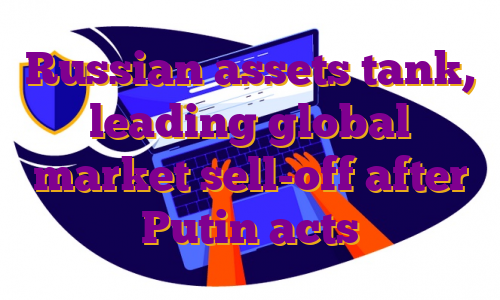Marco Vdm | E+ | Getty ImagesCompany: Wix.com (WIX)Business: Wix.com is an Israeli information technology company that develops and markets a cloud-based platform that enables users to create a website or web application. Their platform consists of three web creation products, each with a different purpose or primary audience: (i) Wix ADI, intended for fast website creation; (ii) the Wix Editor, intended for full website creation targeted at users with basic, average or above average technological skills; and (iii) Editor X, intended for advanced users such as design professionals. As of Dec. 31, 2021, Wix had approximately 222 million registered users and 6 million premium subscriptions.Stock Market Value: $4.2B ($72.21 per share)related investing news
Analysts name the top ‘high conviction’ stocks for playing the market turbulenceActivist: Starboard ValuePercentage Ownership: 9.00%Average Cost: $66.79Activist Commentary: Starboard is a very successful activist investor and has extensive experience helping companies focus on operational efficiency and margin improvement. Starboard also has a successful track record in the information technology sector. In 45 prior engagements, it has a return of 32.36% versus 13.90% for the S&P 500 over the same period. Starboard has had a notable track record with web applications companies going back to 2004 with their 13D investment in Register.com. Register.com was sold to Web.com in 2005 for $135 million, yielding Starboard a 30.82% return versus 11.37% for the S&P 500 over the same period. On June 8, 2018, Starboard filed a 13D on Web.com Group Inc. In October 2018, Web.com was acquired by Siris Capital Group and combined three years later with Endurance International, a comp to GoDaddy’s hosting business. Starboard made a 47.27% return on its Web.com 13D versus a decline of 1.82% for the S&P 500 over the same period. Finally, on Dec. 27, 2021, Starboard filed a 13D on GoDaddy Inc. which is a live 13D where Starboard currently has a 6.12% return versus 19.16% decline for the S&P 500 over the same period.What’s Happening?Behind the ScenesWix is a market leader in web development tools that operates in an attractive space with long-term growth tailwinds. They have a sticky business that is not typically affected in bad economies: People do not shut down their websites in down markets.Prior to Covid, the company was growing in the high teens but growth increased to approximately 30% per year during the pandemic. During this time, Wix increased its cost structure and hired new employees. However, this high rate was not a new, perpetual level of growth as much as it was an accelerant, and since Covid the company’s growth rate has declined to approximately 10%. As a result, Wix’s free cash flow margins declined from 15% to 0%. These margins should not only return to 15% but could exceed 20%.Wix initially targeted 20% FCF margins but that assumed a 20% growth rate. They have since committed to 20% FCF margins by 2025 that is not dependent on 20% growth by implementing a $150 million cost savings program. If the company is committing to 20%, it is very likely that more than that can be done and we have seen companies significantly exceed their estimates before with Starboard involved. As they have done many times in the past, Starboard will work with Wix to help generate a better balance of growth and profitability. While the Rule of 40 (growth rate plus profit margin) for software companies does not squarely apply here, it is certainly analogous and Starboard could work with the company to help it achieve double-digit growth rates and double-digit free cash flow margins.In addition to the cost savings plan, Wix had announced a plan to buy back $500 million of stock. Sounds like things companies do when they know there is an activist at the door. Whatever the motivation, it is good for shareholders that it appears that the company and Starboard are on the same page, and it looks like they can work together to increase shareholder value. Starboard has extensive experience in helping companies optimize growth and margins, typically from a board level. Based on their history and track record, we think this would be best done with Starboard getting one or two seats on the board.While Starboard’s primary objective here is operational, when an activist engages with a company, it often puts that company in pseudo-play getting the attention of strategic investors and private equity. While Starboard is not advocating for any strategic transaction, they are economic animals with fiduciary duties. If an offer came in at the right price, they would weigh it against shareholder value as a standalone entity and do what they believe to be best for shareholders. There has also been speculation that Starboard is trying to get Wix acquired by GoDaddy, as Starboard is one of the largest shareholders of GoDaddy. GoDaddy is not likely the best potential acquirer for this Company and this is not something Starboard would even suggest. If GoDaddy or anyone else showed an interest in acquiring the Company and the Company decided to sell, Starboard would recommend that the Company sell to the best offer after an arms-length sales process.There is one other similarity between Wix and many other Starboard activist positions. It is run by the founder, who often is not the best person to operate a public company. Moreover, in this case, the company’s co-founder, CEO and director Avishai Abrahami; co-founder and VP of client development Nadav Abrahami; and chief architect of research and development Yoav Abrahami, are all brothers. Also, the president and COO, Nir Zohar, is married to the VP Design & Brand, Hagit Zohar. While this could look like a classic case of nepotism and a founder-led company being run like a private firm, this is not necessarily the case here and not likely a focus of Starboard. This management team developed great products resulting in a best-of-breed market leader. Moreover, they are already taking steps to focus on operations. This is not about selling Wix or replacing management, but purely working with the company to focus on free cash flow and shareholder value as opposed to solely focusing on growth.Ken Squire is the founder and president of 13D Monitor, an institutional research service on shareholder activism, and he is the founder and portfolio manager of the 13D Activist Fund, a mutual fund that invests in a portfolio of activist 13D investments. Squire is also the creator of the AESG™ investment category, an activist investment style focused on improving ESG practices of portfolio companies. .
Russian assets tank, leading global market sell-off after Putin acts
A child is seen inside a bus arranged to evacuate local residents, in the rebel-controlled city of Donetsk, Ukraine February 18, 2022.Alexander Ermochenko | ReutersLONDON — Russian assets led a global pullback on Tuesday after Russian President Vladimir Putin ordered troops into two breakaway regions of eastern Ukraine.The Russian ruble slid below 80 to the dollar following Putin’s announcement, its lowest for two years, before recovering to around the 79 mark. The Ukranian hryvnia dropped further however, shedding 2.1% against the ruble. Russia’s MOEX stock index plunged 6% by late morning in Moscow to its lowest point since mid-2020, and was down 4.1% by early afternoon. The RTS Index was last seen down around 6.5%.European markets slid as much as 1.8% at the open on Tuesday morning but retraced the losses about three hours into trading to return to the flatline. Shares in Asia-Pacific closed lower on Tuesday and U.S. stock futures pointed to slight losses on Wall Street later in the day, also paring earlier losses amid volatile premarket trade.Meanwhile oil prices surged, with U.S. crude jumping 4.2% to $95 per barrel and international benchmark Brent crude climbing 2.9% to around $98 per barrel.Digital currencies also took a beating, with bitcoin sinking as low as $36,370 in early morning trade, its lowest level in more than two weeks, before recovering to $37,630 by late morning in Europe.Sanctions expectedIt comes after Putin announced Monday evening that he would recognize the independence of Donetsk and Luhansk and signed a decree calling for forces to enter the two enclaves of the Donbas partially held by Moscow-backed separatists.The United Nations Security Council held an emergency meeting in New York on Monday night as the long-simmering conflict entered a new phase. U.S. President Joe Biden signed an executive order prohibiting new investment, trade and financing from the U.S. to the two breakaway regions.U.K. Health Minister Sajid Javid told Sky News on Tuesday morning that “the invasion of Ukraine has begun.”Broader economic sanctions are expected to be announced by the White House on Tuesday and European foreign affairs ministers are gathering in Brussels to discuss the EU’s next steps.Neil Shearing, group chief economist at Capital Economics, said in a note Tuesday that the impact on Russia’s economy will depend in large part on the response of Western governments.Russian President Vladimir Putin delivers a video address to the nation, following the initiative of the country’s lower house of parliament and security council to recognise two Russian-backed breakaway regions in eastern Ukraine as independent entities, in Moscow, Russia, in this picture released February 21, 2022.Alexey Nikolsky | Sputnik | via Reuters”Its balance sheet is stronger than at the time of the 2014 Crimea crisis – external debt is lower, and financial linkages with other major advanced economies are smaller,” Shearing said.”The imposition of sanctions will still have an impact on the economy, but all other things being equal this is likely to be smaller than in 2014-15 (when GDP fell by ~2.5% and the country experienced a financial crisis).”Berenberg Chief Economist Holger Schmieding said the big uncertainty remains as to whether Putin will move Russian troops further into the Donbas — beyond areas held by pro-Russia groups — encroaching on Kyiv-held free Ukraine.If he stops before this point, “sanctions would weaken the Russian economy over time with very limited impact on the advanced world. Markets would return to normal after a while,” Schmieding said.However, should the situation escalate into a full-scale invasion, Berenberg expects further significant risk-off moves in markets over the next one to two months, followed by a rebound once the outlook becomes clearer, with markets mostly returning to previous trends over the next three to 12 months.Goldman on risk premiumAttempting to quantify how much geopolitical risk is currently priced in by stock markets, Goldman Sachs strategists said Tuesday that their benchmarks implied a discount of around 5% on the S&P 500, 8% on the Stoxx 600, 25 basis points on U.S. 10-year Treasury yield and around 2% on the euro versus the dollar.Larger discounts were seen in European satellite currencies, while gold was estimated to be trading at around a 5% premium based on the risks baked into market pricing year-to-date.”At the moment, USD/RUB stands somewhat above its levels in early January, when tensions around Ukraine began to rise sharply,” the Wall Street giant’s analysts said.”A better measure of the amount of risk premium still priced into the Ruble YTD, however, likely comes from comparing the Ruble to its high-yielding, commodity-exporting EM FX peers, which have seen significant spot gains versus the Dollar in 2022.”On this basis, Goldman Sachs estimated a risk premium from recent escalation of 9% based on Friday’s closing prices, which is likely to have risen following Monday’s escalation.Russia-focused gold miner Petropavlovsk plunged almost 30% over the past two sessions in London, while eastern Europe-exposed carrier Wizz Air also slid disproportionately compared to other airlines, which face cost pressures due to further rises in the oil price.”The threat of Russia invading Ukraine was clearly visible at the end of 2021, but most investors were more concerned about inflation and how fast interest rates might go up,” said Russ Mould, investment director at British retail investment platform AJ Bell.”Now the threat of war is very real, and investors will need to add it to their growing list of things to worry about. This could prompt another bout of panic and lead to heightened market volatility.”Mould suggested that portfolios will likely be reappraised, with investors considering increasing their weighting to cash in order to insulate against the next shock to hit equity markets. .




